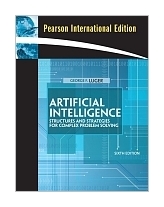In this accessible, comprehensive text, George Luger captures the essence
of artificial intelligence—solving the complex problems that arise wherever computer
technology is applied.
Ideal for an undergraduate course in AI, the Sixth Edition presents the
fundamental concepts of the discipline first then goes into detail with the practical
information necessary to implement the algorithms and strategies discussed. Students learn
how to use a number of different software tools and techniques to address the many
challenges faced by today’s computer scientists.
George Luger is currently a Professor of Computer Science,
Linguistics, and Psychology at the University of New Mexico. He received his PhD from the
University of Pennsylvania and spent five years researching and teaching at the Department
of Artificial Intelligence at the University of Edinburgh.
Table of Contents
PART I: ARTIFICIAL INTELLIGENCE: ITS ROOTS AND SCOPE 1
1 AI: HISTORY AND APPLICATIONS 3
1.1 From Eden to ENIAC: Attitudes toward Intelligence, Knowledge, and
Human Artifice 3
1.2 Overview of AI Application Areas 20
1.3 Artificial Intelligence–A Summary 30
1.4 Epilogue and References 31
1.5 Exercises 33
PART II: ARTIFICIAL INTELLIGENCE AS REPRESENTATION AND SEARCH 35
2 THE PREDICATE CALCULUS 45
2.0 Introduction 45
2.1 The Propositional Calculus 45
2.2 The Predicate Calculus 50
2.3 Using Inference Rules to Produce Predicate Calculus Expressions 62
2.4 Application: A Logic-Based Financial Advisor 73
2.5 Epilogue and References 77
2.6 Exercises 77
3 STRUCTURES AND STRATEGIES FOR STATE SPACE SEARCH 79
3.0 Introduction 79
3.1 Graph Theory 82
3.2 Strategies for State Space Search 93
3.3 Using the State Space to Represent Reasoning with the Predicate Calculus 107
3.4 Epilogue and References 121
3.5 Exercises 121
4 HEURISTIC SEARCH 123
4.0 Introduction 123
4.1 Hill Climbing and Dynamic Programming 127
4.2 The Best-First Search Algorithm 133
4.3 Admissibility, Monotonicity, and Informedness 145
4.4 Using Heuristics in Games 150
4.5 Complexity Issues 157
4.6 Epilogue and References 161
4.7 Exercises 162
5 STOCHASTIC METHODS 165
5.0 Introduction 165
5.1 The Elements of Counting 167
5.2 Elements of Probability Theory 170
5.3 Applications of the Stochastic Methodology 182
5.4 Bayes’ Theorem 184
5.5 Epilogue and References 190
5.6 Exercises 191
6 CONTROL AND IMPLEMENTATION OF STATE SPACE SEARCH 193
6.0 Introduction 193
6.1 Recursion-Based Search 194
6.2 Production Systems 200
6.3 The Blackboard Architecture for Problem Solving 187
6.4 Epilogue and References 219
6.5 Exercises 220
PART III CAPTURING INTELLIGENCE: THE AI CHALLENGE 223
7 KNOWLEDGE REPRESENTATION 227
7.0 Issues in Knowledge Representation 227
7.1 A Brief History of AI Representational Systems 228
7.2 Conceptual Graphs: A Network Language 248
7.3 Alternative Representations and Ontologies 258
7.4 Agent Based and Distributed Problem Solving 265
7.5 Epilogue and References 270
7.6 Exercises 273
8 STRONG METHOD PROBLEM SOLVING 277
8.0 Introduction 277
8.1 Overview of Expert System Technology 279
8.2 Rule-Based Expert Systems 286
8.3 Model-Based, Case Based, and Hybrid Systems 298
8.4 Planning 314
8.5 Epilogue and References 329
8.6 Exercises 331
9 REASONING IN UNCERTAIN SITUATIONS 333
9.0 Introduction 333
9.1 Logic-Based Abductive Inference 335
9.2 Abduction: Alternatives to Logic 350
9.3 The Stochastic Approach to Uncertainty 363
9.4 Epilogue and References 378
9.5 Exercises 380
PART IV: MACHINE LEARNING 385
10 MACHINE LEARNING: SYMBOL-BASED 387
10.0 Introduction 387
10.1 A Framework for Symbol-based Learning 390
10.2 Version Space Search 396
10.3 The ID3 Decision Tree Induction Algorithm 408
10.4 Inductive Bias and Learnability 417
10.5 Knowledge and Learning 422
10.6 Unsupervised Learning 433
10.7 Reinforcement Learning 442
10.8 Epilogue and References 449
10.9 Exercises 450
11 MACHINE LEARNING: CONNECTIONIST 453
11.0 Introduction 453
11.1 Foundations for Connectionist Networks 455
11.2 Perceptron Learning 458
11.3 Backpropagation Learning 467
11.4 Competitive Learning 474
11.5 Hebbian Coincidence Learning 484
11.6 Attractor Networks or “Memories” 495
11.7 Epilogue and References 505
11.8 Exercises 506
12 MACHINE LEARNING: GENETIC AND EMERGENT 507
12.0 Genetic and Emergent Models of Learning 507
12.1 The Genetic Algorithm 509
12.2 Classifier Systems and Genetic Programming 519
12.3 Artificial Life and Society-Based Learning 530
12.4 Epilogue and References 541
12.5 Exercises 542
13 MACHINE LEARNING: PROBABILISTIC 543
13.0 Stochastic and Dynamic Models of Learning 543
13.1 Hidden Markov Models (HMMs) 544
13.2 Dynamic Bayesian Networks and Learning 554
13.3 Stochastic Extensions to Reinforcement Learning 564
13.4 Epilogue and References 568
13.5 Exercises 570
PART V: ADVANCED TOPICS FOR AI PROBLEM SOLVING 573
14 AUTOMATED REASONING 575
14.0 Introduction to Weak Methods in Theorem Proving 575
14.1 The General Problem Solver and Difference Tables 576
14.2 Resolution Theorem Proving 582
14.3 PROLOG and Automated Reasoning 603
14.4 Further Issues in Automated Reasoning 609
14.5 Epilogue and References 666
14.6 Exercises 667
15 UNDERSTANDING NATURAL LANGUAGE 619
15.0 The Natural Language Understanding Problem 619
15.1 Deconstructing Language: An Analysis 622
15.2 Syntax 625
15.3 Transition Network Parsers and Semantics 633
15.4 Stochastic Tools for Language Understanding 649
15.5 Natural Language Applications 658
15.6 Epilogue and References 630
15.7 Exercises 632
PART VI: EPILOGUE 671
16 ARTIFICIAL INTELLIGENCE AS EMPIRICAL ENQUIRY 673
16.0 Introduction 673
16.1 Artificial Intelligence: A Revised Definition 675
16.2 The Science of Intelligent Systems 688
16.3 AI: Current Challanges and Future Direstions 698
16.4 Epilogue and References 703
Bibliography 705
Author Index 735
Subject Index 743
784 pages, Paperback


